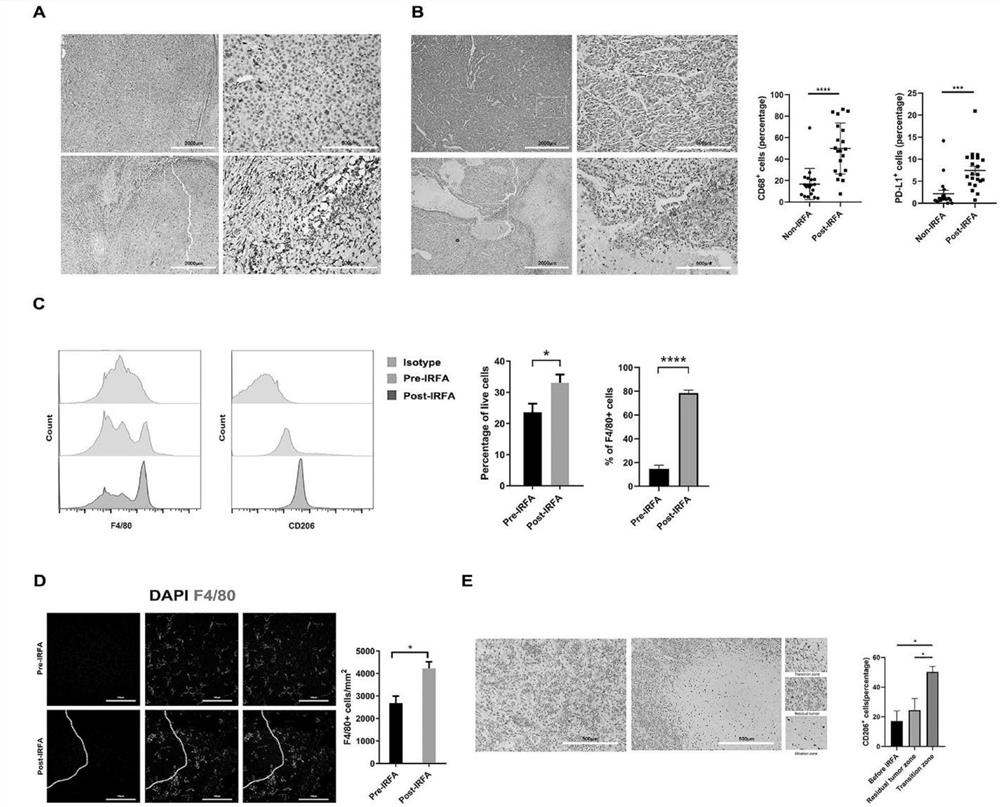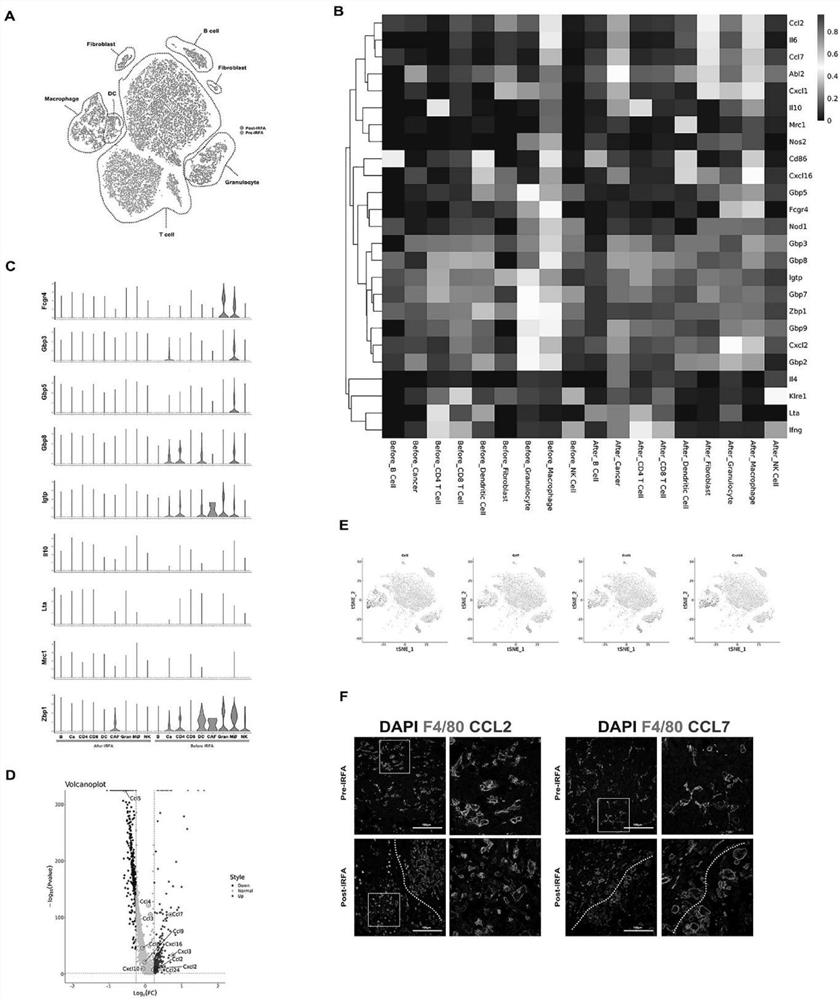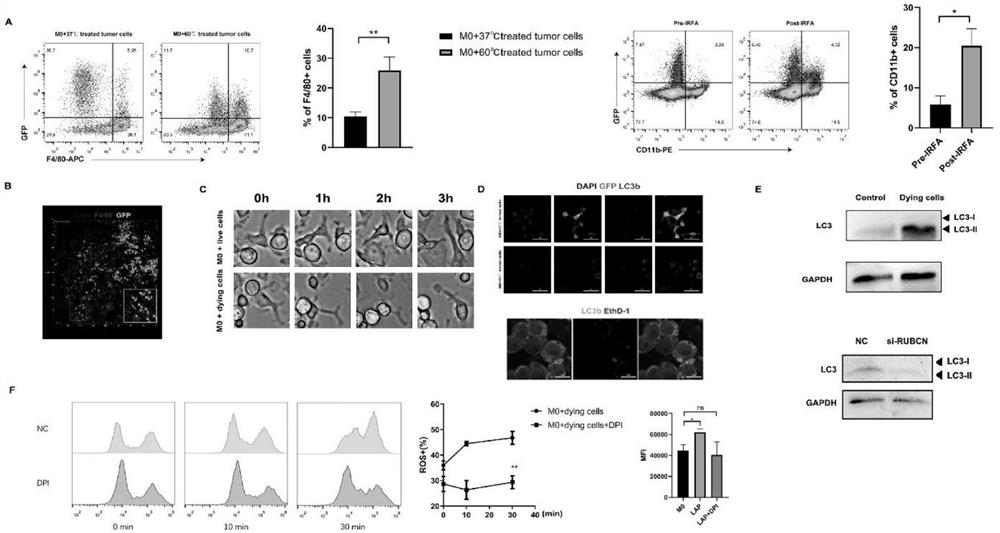Application of PI3K gamma inhibitor in treatment of radiofrequency ablation residual tumor
A technology of radiofrequency ablation and inhibitors, which is applied in the direction of antineoplastic drugs, microbial measurement/inspection, and medical preparations containing active ingredients, etc. It can solve the problems of lack of treatment methods, improve survival rate, inhibit recurrence, and prolong survival period effect
- Summary
- Abstract
- Description
- Claims
- Application Information
AI Technical Summary
Problems solved by technology
Method used
Image
Examples
Embodiment 1
[0057] Increased number of macrophages in residual tumor after IRFA
[0058] (1) Liver cancer sample research
[0059] In order to study whether residual tumors recruit macrophages after IRFA, a retrospective study was conducted on some patients with liver cancer in Sun Yat-sen Memorial Hospital of Sun Yat-sen University. Among them, 21 patients who underwent tumor resection after RFA due to recurrence were assigned to the RFA group, and 19 patients who received primary tumor resection were assigned to the RFA group. Patients who underwent tumor resection but did not undergo RFA were assigned to the non-RFA group, and there were no differences in clinical, biological, and histological characteristics.
[0060] In specimens, a higher number of tumor-infiltrating CD68 was observed in the RFA group compared to the non-RFA group + macrophages, with more infiltration around the ablation zone (eg figure 1 shown in A). Moreover, according to existing research records, for simple r...
Embodiment 2
[0069] Immunosuppressive function of macrophages after IRFA identified by single-cell transcriptome
[0070] Using the IRFA animal model, tumor cells from the NC and IRFA groups were collected. Two groups of freshly isolated tumors were rapidly dissociated and subjected to fluorescence-activated cell sorting (FACS) to obtain viable single cells. Then, cDNA was prepared from individual cells, a single-cell RNA-seq library was constructed, and next-generation sequencing (NGS) was performed. A total of 10690 cells were analyzed in the NC group, and 9672 cells were analyzed in the IRFA group. Among them, 99.85% of the cells in the NC group and 99.7% of the cells in the IRFA group passed the quality control. The average number of mapped reads per cell was approximately 8000 for the NC group and 7000 for the IRFA group. The median number of genes per cell was 726 and 1038 for the NC and IRFA groups, respectively. For non-malignant cells, these clusters of non-malignant cells wer...
Embodiment 3
[0076] 1. Phagocytosis of heat-treated tumor cells by macrophages
[0077] As shown in Example 1, macrophages aggregated around the transition zone (TZ) after IRFA ( figure 1D). In order to obtain the relationship between heat-treated tumor cells and macrophages, the inventors first established a heat-treated tumor cell model based on previous studies. Hepa1-6 cells were exposed at 60°C for 10 minutes and then stained with PI / Annexin V. Compared with the tumor cells at 37 °C, the tumor cells after heat treatment showed a significantly higher proportion of Annexin V and PI positive cells ( Figure 10 A). Heat-treated cells were further assessed by membrane-impermeable nuclear fluorescent dyes, Ethidium Homodimer 1 (EthD-1) and Cleaved-Caspase-7 (e.g. Figure 10 B, C).
[0078] We then extracted bone marrow-derived macrophages (BMDMs) and induced their maturation, using flow cytometry to determine the purity of the macrophages ( Figure 10 D).
[0079] A Hepa1-6 cell line...
PUM
 Login to View More
Login to View More Abstract
Description
Claims
Application Information
 Login to View More
Login to View More - R&D
- Intellectual Property
- Life Sciences
- Materials
- Tech Scout
- Unparalleled Data Quality
- Higher Quality Content
- 60% Fewer Hallucinations
Browse by: Latest US Patents, China's latest patents, Technical Efficacy Thesaurus, Application Domain, Technology Topic, Popular Technical Reports.
© 2025 PatSnap. All rights reserved.Legal|Privacy policy|Modern Slavery Act Transparency Statement|Sitemap|About US| Contact US: help@patsnap.com



